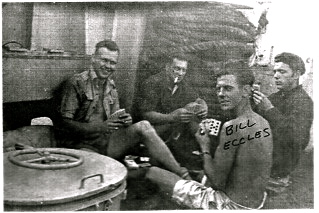"We Anchor Offshore.... and Watch the Show"
William Eccles and mates enjoy some 'R and R' aboard LCI(L) 295
Mr. Eccles' mate (far left in top photo) ready for action
Photo credit - From the collection of Reg Eccles
Mr. Eccles' mate (far left in top photo) ready for action
Photo credit - From the collection of Reg Eccles
Introduction:
The Allied invasion of Normandy, France began on June 6, 1944 and included the participation of Canadians in Combined Operations (members of RCNVR in many cases) aboard Landing Craft, Infantry (Large) (aka LCI(L).
Preparations for D-Day Normandy, known as Operation OVERLORD (and Operation NEPTUNE when considering just the naval side of the total plan) was a massive undertaking. Plans included, on the part of Canada, the construction and manning of 30 LCI(L)s to move troops and materials of war ashore on the west side of the British Zone, as seen in the map below, as found on page 232 in St. Nazaire to Singapore, Vol. 2.
Countless men and weapons of war were landed and assailed the coastline of France in hopes of overpowering and defeating Axis Forces and ending World War II.
In St. Nazaire to Singapore, Vol. 2 one can read a few more details about the men and work of the LCI(L)s, including LCI(L) 295 - upon which William Eccles and his mates served - one of seven large landing crafts part of the 264th Canadian Flotilla.
For example, from page 227, we read the following about an incident that occurred during a particular day of training near Southampton, right beside Eccles and landing craft 295:
The Mine Incident Outside Weymouth
By John T. Corcoran, AB, RCNVR (LCI(L) 310, 264th Flotilla)
One morning, during manoeuvres, we were the lead ship in the port column in the line ahead formation. It was a perfect day, the sun was out, not a cloud in the sky.... I must admit, it was a sight to behold, Canadian, British and American LCI(L)s alternating from the line ahead to line abreast in single and double formation....
Suddenly the bow lookout (Corcoran) acted very strangely, jumping up and down, waving his arms....
Then we saw it - 30 yards ahead - an ugly mine three quarters submerged. Only the top and horns out of the water....
The craft was sluggish on the port turn and LT Campbell in the LCI(L) 295 was close on the starboard side.
Then we hit it, not a glancing blow on the side, but dead centre on our wide flat-bottomed bow. The force of the blow must have loosened every rivet in our superstructure, but the mine did not explode. Thank Goodness!
But that was only the beginning of our troubles....
(Please click here to read the rest of the story).
Eyewitness accounts and photographs provided by William Eccles of day to day action aboard LCI(L) 295 are very valuable, as well as rare and illuminating. More from William's journal and photo collection are provided below.
From June 6, 1944:
Below is the view of the coastline from LCI(L) 295. A Landing Craft, Tank (LCT) can be seen approaching the beach east of Arromanches, France.
Troops disembark from LCI(L) 305 of the 264th Canadian Flotilla. To its right is LCI(L) 295, with gangplanks almost ready for disembarkation of troops. LCT 555 is far right, bow still up:
A portable dock, aka Rhino bridge (I believe) is used by troops and trucks for faster disembarkation:
More from the journal of William Eccles, from D-Day +3:
More to follow.
Other details related to events that occurred after D-Day are provided in Part 1.






